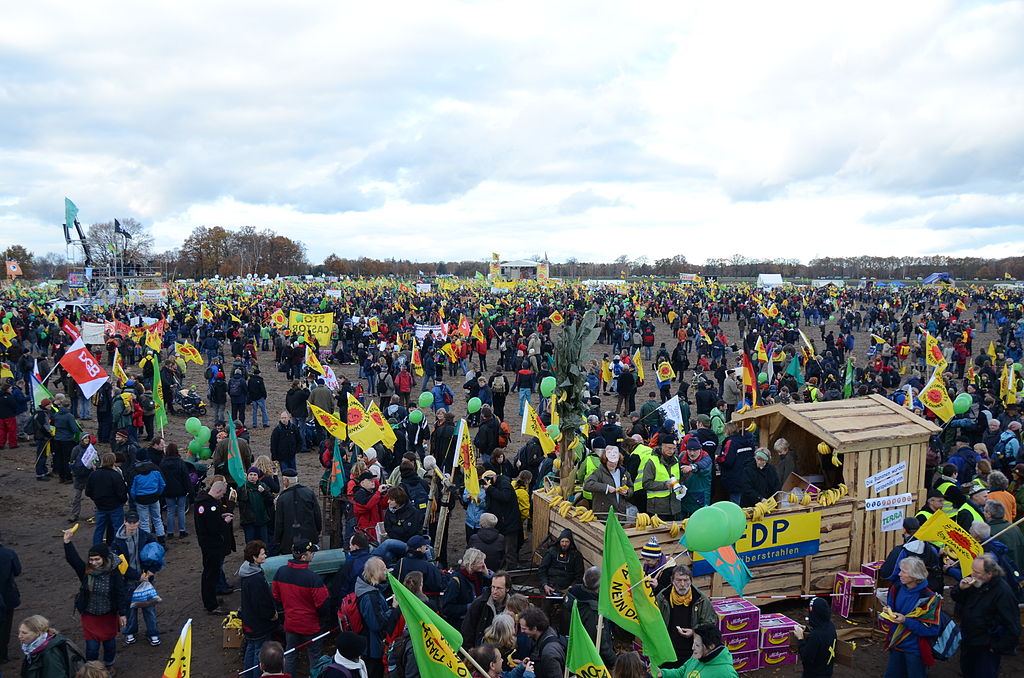As already described in our article “The economic miracle brings nuclear power plants“, the expansion of nuclear power plants boomed in the 1970s. After the two oil crises, nuclear power plants were supposed to guarantee more independence from foreign energy sources. Therefore, in 1974, eleven nuclear power plants were in operation in the Federal Republic of Germany, eleven more were under construction and six were in the already approved project planning phase. Until then, however, the majority of the expansion was still supported by the population. Nuclear power plants were considered a modern and clean form of electricity generation. The nuclear phase-out has a long history with much back and forth.
In 1975, there is initial resistance to the construction of a nuclear power plant
In 1975, the operators of nuclear power plants encountered resistance from the population for the first time. In Wyhl am Kaiserstuhl, a citizens’ initiative collected 90,000 signatures and occupied the construction site for the planned nuclear power plant for eight months. The construction of the Wyhl nuclear power plant was finally abandoned after years of court action to halt construction. “If this example sets a precedent, this country will no longer be governable,” the then Minister President of Baden-Württemberg, Filbinger, stated in this regard.

Image: Bündnis 90/Die Grünen Nordrhein-Westfalen, CC BY-SA 2.0, via Wikimedia Commons
The protest movement becomes militant
However, the success of the protest movement quickly set a precedent. Just one year later, there was also massive resistance in Brokdorf in Schleswig-Holstein. However, the nuclear industry was forewarned by the protests and had the site secured like a fortress. Therefore, the demonstrations in Brokdorf escalated into civil war-like battles. For the first time, the police used helicopters, water cannons and tear gas against thousands of protesters. Among them, for the first time, were militant groups who attacked the police with weapons and projectiles. The protests in Brokdorf marked the beginning of the nationwide anti-nuclear movement, which eventually gave rise to the Green Party.
Nuclear accidents in Harrisburg and Chernobyl fuel fear among the population
On 28 March 1979 a serious nuclear accident occurred in Harrisburg and on 26 April 1986 the Chernobyl disaster. These two events led to ever greater fear among the population about the consequences of nuclear energy. There were even several deaths during the protests over the construction of the reprocessing plant in Wackersdorf in spring 1986. These events were practically the reason that the highly emotionally charged issue made the further expansion of nuclear energy politically impossible from the mid-1980s onwards.
In 1998, the red-green coalition decides to phase out nuclear power.
In 1998, the Greens came to government at the federal level for the first time in the Red-Green coalition. In 2000, the red-green government first decided to phase out nuclear power by 2020. At that time, however, the decision to phase out nuclear power was still highly controversial politically and socially. With this decision to phase out nuclear power, the protests also became fewer and quieter.
Castor transports revive protest movement
The protests resurged with the Castor transports in 1995. In the process, the anti-nuclear movement in Germany experienced a revival. Already six months before the first planned transport, demonstrations and road blockades were planned. There were also radical actions in which pieces of rail were cut out of the tracks. The police secured the first transport with 15,000 security forces. This was the largest police operation in post-war history.
Merkel advertises in election campaign to reverse nuclear phase-out
In the 2003 election campaign, CDU party leader Angela Merkel was still campaigning to reverse the nuclear phase-out. She accused the red-green federal government of “pushing entire markets abroad. Whether it is the pharmaceutical industry, genetic research or nuclear energy, many future-oriented industries are being driven out of Germany. In 2009, the government under Merkel extended the operating times of nuclear power plants again. In the same year, she campaigned in NRW with her coalition partner Westerwelle to reverse the nuclear phase-out.
After Fukushima, Merkel decides final phase-out for German nuclear power plants
However, with the nuclear accident in Fukushima, Japan, on 11 March 2011, it fundamentally changed these plans and immediately suspended the extension of operating times. On 6 June 2011, the seven oldest nuclear power plants and the Krümmel nuclear power plant were taken off the grid for three months as a precautionary measure and were shortly afterwards permanently shut down. Today, only three German nuclear power plants still produce electricity. These will also stop producing electricity for good at the end of 2022. This comes at a time when the independence of foreign energy sources is once again being discussed and more and more people are calling for an extension of the operating times.
The following articles have appeared so far in our short series on the history of electricity generation:
